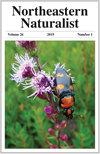纽约北部和阿迪朗达克群岛的鱼类
IF 0.5
4区 环境科学与生态学
Q4 BIODIVERSITY CONSERVATION
引用次数: 0
摘要
摘要:对纽约北部鱼类的了解有助于保护规划和景观解释。本报告借鉴了20世纪30年代至2018年的鱼类调查,总结和解释了包括阿迪朗达克山脉在内的周边地区鱼类的分布。研究区海拔梯度宽,包括低地和高地生态区,并对其鱼类组合进行了比较。低地是向高地迁移的历史障碍的下游水域(海拔62-215米,取决于景观坡度)。高地是指海拔高于低地(168米以上)的水域,包括过渡和阿迪朗达克山脉的海拔(305米以上)。在纽约北部,总共记录了114种鱼类和2种杂交种;为了方便起见,杂交种在这里按物种表列。116个分类群中,111个在低地。尽管低地和高地的出生模式有所不同,但80%的人是纽约州本地人。具体来说,土著人占低地群体的80%,高地群体的51%。许多原产于低地的物种不会在高地自然出现,只有在转移或放养后才在高地广泛分布。非本地物种的持续扩张造成了鱼类群落的变化和本地物种的损失。在高地,3种本地物种已经消失,另外3种急剧减少。在低地,随着时间的推移,物种状况的变化相对较小。对116个分类群分别作了简要的注释,包括最近的研究概况、1989年12月前后的状况变化和建议的保护分类。本文章由计算机程序翻译,如有差异,请以英文原文为准。
Fishes of Northern New York and the Adirondacks
Abstract - Knowledge of the fishes of northern New York can help with conservation planning and landscape interpretations. This report draws from fish surveys from the 1930s to 2018 to summarize and interpret the distribution of fishes in the region surrounding and including the Adirondacks. The study area, with its broad elevational gradient, includes lowland and upland ecoregions, for which we compare fish assemblages. Lowlands are the waters downstream of historic barriers to migration into the uplands (elevations of 62–215 m, depending on landscape slope). Uplands are the waters at higher elevations than the lowlands (above 168 m) that include the transitional and Adirondacks' elevations (above 305 m). In total, 114 fish species and 2 hybrids have been documented in northern New York; for the sake of convenience, the hybrids are tabulated as species here. Of the 116 taxa, 111 are in lowlands. Eighty percent are native to New York State, although patterns of nativity differ between the lowlands and the uplands. Specifically, natives make up 80% of the lowland group and 51% of upland group. Many of the species that are native to the lowlands do not occur naturally in the uplands, becoming widespread there only after transferal or stocking. The continued expansion of non-native species has caused changes in fish communities and losses of native species. In the uplands, 3 native species have been lost and 3 others dramatically reduced. In the lowlands, there has been relatively little change in species status over time. Brief annotations are provided for each of the 116 taxa, including summaries of recent studies, changes in their status before and after December 1989, and proposed conservation classifications.
求助全文
通过发布文献求助,成功后即可免费获取论文全文。
去求助
来源期刊

Northeastern Naturalist
环境科学-生态学
CiteScore
1.10
自引率
0.00%
发文量
42
审稿时长
18-36 weeks
期刊介绍:
The Northeastern Naturalist covers all aspects of the natural history sciences of terrestrial, freshwater, and marine organisms and the environments of the northeastern portion of North America, roughly bounded from Virginia to Missouri, north to Minnesota and Nunavut, east to Newfoundland, and south back to Virginia. Manuscripts based on field studies outside of this region that provide information on species within this region may be considered at the Editor’s discretion.
The journal welcomes manuscripts based on observations and research focused on the biology of terrestrial, freshwater, and marine organisms and communities as it relates to their life histories and their function within, use of, and adaptation to the environment and the habitats in which they are found, as well as on the ecology and conservation of species and habitats. Such studies may encompass measurements, surveys, and/or experiments in the field, under lab conditions, or utilizing museum and herbarium specimens. Subject areas include, but are not limited to, anatomy, behavior, biogeography, biology, conservation, evolution, ecology, genetics, parasitology, physiology, population biology, and taxonomy. Strict lab, modeling, and simulation studies on natural history aspects of the region, without any field component, will be considered for publication as long as the research has direct and clear significance to field naturalists and the manuscript discusses these implications.
 求助内容:
求助内容: 应助结果提醒方式:
应助结果提醒方式:


